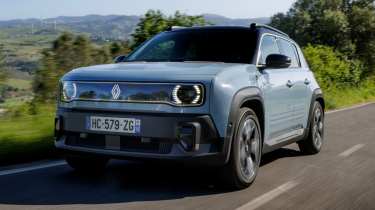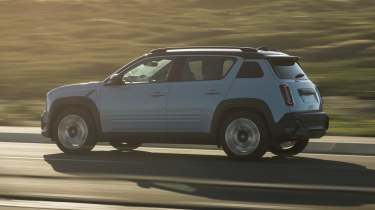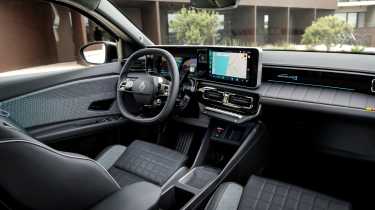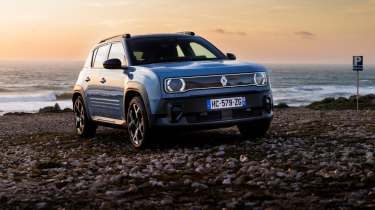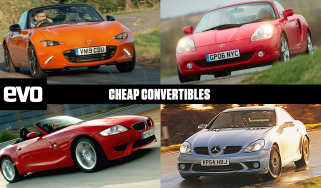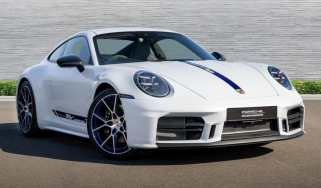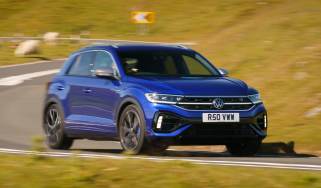Renault 4 2025 review – retro crossover takes aim at the MG4
The revived Renault 4 hopes to continue the success of its smaller 5 sibling, and on first impressions it seems well placed to do just that
The Renault 5 has taken the automotive world by storm, proving that retro-inspired revivals really do have a place in the mainstream market when properly executed. Despite humble underpinnings it’s even proven a hit with enthusiasts thanks to its charming looks, everyday usability and strong dynamics. Now Renault is launching another model of the same ilk, reviving the 4 after a three-decade hiatus.
The 5 might be a stereotypical hatch, but the Renault 4 happened to be the world’s first mass-produced hatchback when it was launched in 1961. This new car might be more of a crossover, marginally larger than the 5, but it’s still modest in both dimensions and price, based on the same AmpR Small platform.
Its design is more ordinary than the 5’s on first impressions, but the 4 references elements of the original for the same retro charm, with a large single-piece front grille (boldly illuminated from mid spec and above), those twin round headlights, trapezoidal rear windows and three-piece rear lights most notable – it comes with three distinct embossed lines in the doors to reference the plastic protector strips of the original, too, with a unique ‘plein sud’ fabric roof to launch at a later date for ‘techno’ and ’iconic’ spec. The 5’s got the jump, but Renault has given the 4 plenty of its own unique appeal with this feature alone.
More reviews
Group tests
- Alpine A290 v Alpine A110 – how much DNA do they really share?
- Ariel Atom 4R v Caterham Seven ‘evo25’: power-to-weight heroes go head-to-head
- Bentley Continental GT Speed v Aston Martin DB12 v Maserati GranTurismo – which is the ultimate grand tourer?
- Caterham Super Seven 600 v Super Seven 2000
- Levante v T1
- Corvette Stingray v Porsche Cayman GTS v Audi R8 RWD
- Volkswagen Golf GTI Clubsport v Cupra Leon 300 – what's the best mainstream hot hatch?
- Great Ferrari hypercars driven: 288 GTO, F40, F50 and Enzo head-to-head
- GMA T.50 v McLaren F1 – has the best car in the world been dethroned by its successor?
- Lamborghini Aventador Ultimae v Lamborghini Countach
In-depth reviews
- Abarth 600e 2025 review – Italy gives the Alpine A290 something to worry about
- Alpine A110 2025 review – one of the all-time sports car greats will soon be gone
- Aston Martin Vantage 2025 review – a thrilling alternative to the McLaren Artura
- Audi R8 (2015 - 2024) review – the ultimate soft-focus supercar
- BMW iX 2025 review – the ugly duckling still stomps the Tesla Model X
Long term tests
- Abarth 695C Turismo Fast Fleet test – 10,000 miles in the Italian hot hatch
- Alfa Romeo Giulia Veloce Fast Fleet test – living with the sharp Italian saloon
- Alpina B10: end of term report
- Alpina B10
- Caterham Seven evo25 Fast Fleet test – living with a track car for the road
- Caterham Seven evo Edition revealed – bespoke 420R joins the Fast Fleet
- Cupra Leon Estate 310 4Drive Fast Fleet test – living with the 306bhp hot estate
- Ford Mustang GT
- Ford Mustang GT
- Land Rover Defender 110 Fast Fleet test – 9000 miles in the go-anywhere SUV
Review
- New Aston Martin DBS 770 Ultimate review – 759bhp super-GT driven
- New Bentley Batur 2023 review – can it possibly be worth £1.65m?
- 2023 Chevrolet Corvette C8 Z06 review – the American 911 GT3?
- Kia EV6 GT-Line S prototype review – the EV that shows how it’s done
- BBR Supercharged Mazda MX-5 (ND) 2023 review – tuned 250bhp roadster driven
- MG4 Trophy 2023 review
Reviews
- Abarth 695 75 Anniversario edition 2024 review – a fitting send-off for Abarth’s hot supermini?
- Abarth 500e 2023 review
- AC Cobra 378 Superblower MkIV 2021 review – another V8 Cobra, but with a GM heart this time
- Acura Integra Type S 2024 review – a Honda Civic Type R with added restraint
- Alfa Romeo Giulia 2025 review – get one while you still can
- Alfa Romeo 33 Stradale 2025 review – a rare Italian jewel beyond compare
- Alfa Romeo SZ: history, review and specs of an icon
The Renault 4 has a tough task on its hands to match the incredible success of the original (of which over 8 million were sold), but if the reception of its 5 sibling is anything to go by, there’s a good chance it’ll stand Renault in good stead. We got behind the wheel for the first time on the international launch in Portugal to find out if it’s worth the premium over the 5.
Motor, battery and 0-62mph time
- One powertrain option
- 148bhp
- 247 miles of range
If you’re familiar with the Renault 5 there won’t be many surprises here. In the UK there’s just a single powertrain option, pairing a 52kWh (useable) battery pack with a single front-mounted electric motor. Like in the 5, output stands at an identical 148bhp and 181lb ft of torque, and thanks to surprisingly minimal weight gain, it only takes two tenths longer to hit 62mph at 8.2sec – top speed stands at 93mph.
On the road, similarities extend to beyond just the numbers. The 4 has the same satisfying zip as the 5, and while there’s no doubt it lacks the top end pull of a performance model, there’s more than enough potency on tap for the task at hand. The Renault 4 hits the speed limit without a fuss, chirping its 195-section Michelin e-Primacy EV front tyres under acceleration if you ask for it – a steep hill will have you matting the throttle to maintain a good level of progress, but this is to be expected.
> Renault 5 2025 review - £23k fun electric hatch with some of the original's spirit
Where the 4 does differ from the 5 is its use of steering wheel-mounted paddles for adjusting regenerative braking. These paddles are tactile and well placed to allow for regen adjustment mid-corner, and even a more aggressive one-pedal driving function that the 5 goes without. Where some one pedal systems are hard to acclimatise to, the 4’s is nicely judged, making smooth, energy efficient stops easily achievable – Renault says this is a feature that will trickle down to the 5 at a later date.
With the same power output, standard heat pump and 52kWh battery pack as the 5, quoted range and efficiency figures are close. Renault quotes a WLTP figure of 247 miles, just seven miles fewer than the 5 when equipped with the same battery pack – the Fiat 600e manages marginally more at 254 miles, with the 51kWh MG4 at a much less attractive 218 miles. When fitted with the incoming retractable fabric roof, a minor hit to aerodynamic efficiency will see range drop by just two miles.
Ride and handling
- Well-judged ride
- Decent body control
- Light steering has no feel
It might be (slightly) more practical than its popular relative, but the 4 is near-identical under the skin. The wheelbase has increased by 8cm to accommodate more inside, but even so, it’s gained just 6kg at 1462kg (the retractable plein sud fabric roof adds just 10kg). Though this is over twice the weight of the original car, it’s a respectable figure in today’s world, with even the smaller Mini Cooper SE tipping the scales at a portly 1605kg.
Renault says that while it shares the same Dacia Duster-derived multi-link rear axle with the 5, it has given the 4 a dedicated chassis tune with more suspension travel, softer spring rates and a slight drop in agility in the pursuit of increased comfort. On the road this change isn’t immediately noticeable, but the ride is well-judged nonetheless (on sun-soaked Portuguese tarmac, at least), with body control and secondary ride strong for a car at this price point – chunky 60 profile tyres will also contribute to this.
The thin-rimmed steering wheel and the same fast steering rack as the 5 make the front end positive too, encouraging a more spirited drive than its looks might suggest – steering is light and free of feel, but then this is a practical electric crossover.
That multi-link rear axle does leave room for a rear-mounted motor, and while Renault hasn’t confirmed an all-wheel drive variant, its rugged styling and practical cabin certainly would lend itself well to this. Sadly a hot rally-inspired Alpine version is not on the cards, for now.
Driver's note
'The new Renault 4 would have a tough task on its hands to match the incredible eight million-strong production run of the original during its 33-year run, but like the new Renault 5, it demonstrates that not all electric cars have to be instantly forgettable.' – Sam Jenkins, evo senior staff writer, who tested the Renault 4 on the launch.
Interior and tech
- Dash borrowed from the R5
- Denim trim sets it apart
- More spacious and practical
Its exterior design might not have quite the same immediate draw as the 5, but the cabin certainly does. The 4 borrows the dash from the 5, with the handy storage cubbies, physical climate control toggles and steering wheel identical. The seats in the Techno trim car we tested also had a good level of bolstering for support, making longer journeys less tiresome.
Renault has given the 4 unique upholstery to set it apart, though, with the Techno trim featuring contrast-stitched denim on the dash, seats and on the door cards front and rear – there are even weathered jean fasteners on the seats coloured in bronze to match the stitching. For a different aesthetic, there’s the Iconic trim, giving you an excellent quilted leather and patterned fabric blend throughout. The 4 also gets the same cool patterned ‘3D’ headliner as the 5, adding another element of texture and character to the cabin. Buyers can add further character with customisable elements, including 3D printed inserts and the same baguette holder seen in the 5, if you’re into that.
A 22cm increase in overall length provides a noticeable increase in rear leg room in the back (16.4cm to be precise), and where some cars sacrifice boot space to make this change, the 4 does not – the boot is impressive for a car of this size at 420 litres, a whole 100 litres more than the 5. Renault has also introduced hands-free opening, and designed the sill to be as low as possible for easy loading, just like the original 4.
Dual displays come as standard, with the driver’s display 7 or 10 inches depending on spec, and the central infotainment display at 10.1-inches. This central display seems a little small on first impressions, but it’s neatly mounted nonetheless, with sharp graphics and standard Google integration making it excellent to use even without relying on Apple CarPlay or Android Auto.
Elsewhere in the tech department, the top spec car gets the full suite of 26 driver assistance systems, which can be quickly deactivated via a dedicated button to the left of the steering wheel. The backup camera is low res, but functional, and there’s also digital key functionality which will come in handy for some.
The only real indicator you're in such a low cost car is the introduction of wind noise around the A-pillar from relatively low speeds, but as in any silent-running EV, this is undoubtedly a development pain point. Thankfully in the Renault 4, it's far from a deal breaker.
Not only does its bold upholstery make it attractive from the get-go, the fit and finish is strong too. The buttons, stalks and handles all feel reassuringly solid, well-damped and of a quality you’d usually associate with a much more premium product. Small but meaningful design touches and drive mode memory on restart also make it feel like a nicely polished product.
Price, specs and rivals
We will receive just a single powertrain option in the UK across three trim levels: Evolution, Techno and Iconic. A heat pump is standard from the bottom of the range, but if you’re looking for the incoming Plein sud fabric roof option you’ll have to opt for the Techno trim and above. The Renault 4 is priced from £26,995 on the road in evolution trim, rising to £28,995 for the techno and to £30,995 for the iconic spec.
While the standard car is reasonably well appointed, Techno gets you adaptive cruise control and the paddles for adjusting the regenerative braking. On the outside you get a neater 'shark fin' antenna, roof bars, rear privacy glass and silver trim around the front 'grille'. On the inside you get the larger 10.3-inch driver's display, wireless phone charging, Arkamys Auditorium audio, ambient lighting and more.
Iconic spec adds the 18-inch 'Parisenne' wheels and uprated interior trim and the illuminated 'Renault 4' symbol on the dash, as well as the full active driver assist with contextual cruise control and traffic sign recognition. Oddly, if you’re looking for a heated seat and steering wheel you’ll need to opt for the range-topper in the UK too – some other markets receive these from the middle of the range.
Does £26,995 for a base Renault 4 seem quite the jump over the £23,000 starting price of the 5 at first? Yes but you need to remember, the 4 comes as standard with the larger 52kWh battery pack, making it just £2000 more expensive than the 5 spec-for-spec.
Look to its rivals and the Renault 4 offers strong value, with the Mini Aceman starting from a higher £28,905, the Fiat 600e from £30,025 and the MG4 at a near-identical £26,995.
Renault is taking deposits for the 4 in July 2025 before first customer cars hit the road in September.
Renault 4 specs
| Renault 4 | |
|---|---|
| Power | 148bhp |
| Torque | 181lb ft |
| Powertrain | Single motor, front-wheel drive |
| Top speed | 93mph |
| 0-62mph | 8.2sec |
| Weight | 1462kg |
| Battery | 52kWh useable |
| Range (WLTP) | 247 miles |
| Charging speed | Up to 100kw |
